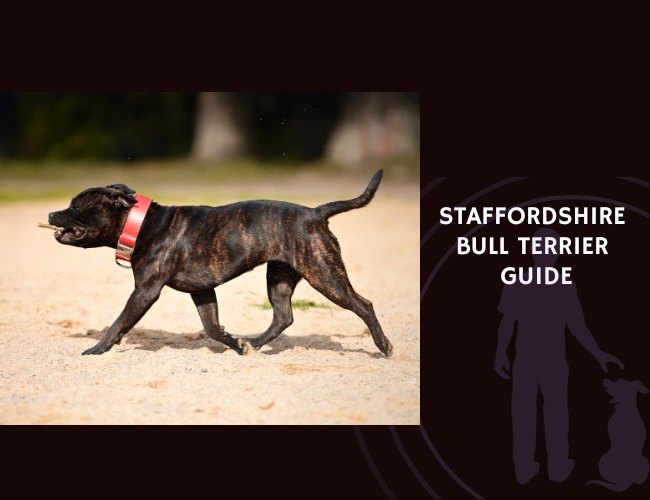Quick Facts about the Staffordshire Bull Terrier
- Origin: United Kingdom
- Weight: 13–17 kg (male), 11–15 kg (female)
- Life expectancy: 12–14 years
- Coat Colour: Black, white, blue, fawn, red, brindle, or any of these with white
- Breed Group: Terrier
The Staffordshire Bull Terrier is a muscular, compact breed with a big heart and a fearless, loving nature. Often called a “nanny dog” for its fondness for children, it combines strength, courage, and deep devotion to family.
Staffordshire Bull Terrier History
The Staffordshire Bull Terrier originated in 19th-century England, bred from Bulldogs and terriers for use in blood sports like bull-baiting and dog fighting. When such sports were outlawed, the breed was gradually refined to be a stable and affectionate companion dog, especially cherished among working-class families.
It was recognised by The Kennel Club in 1935 and by the AKC in 1974. Today, it is loved for its loyalty, tenacity, and affectionate personality.

Staffordshire Bull Terrier Temperament
Loving, bold, and loyal, the Staffordshire Bull Terrier thrives in close connection with its humans. It is affectionate—often exuberantly so—and especially fond of children, earning it the nickname “the children’s nursemaid” in the UK.
While friendly with people, it may show aggression toward unfamiliar dogs, particularly of the same sex. Early socialisation and responsible handling are crucial. This breed is confident, eager to please, and responds well to structured, positive training.
Note: Despite its reputation, a well-raised Stafford is among the most trustworthy and stable companions.
Health and wellness
Staffies are athletic and thrive on daily walks, play, and mental stimulation. They enjoy tug games, scent work, and short training sessions.
Their short, smooth coat is low-maintenance but offers little protection in cold weather. They benefit from regular brushing and skin checks.
Significant problems:
Hereditary cataracts and eye issues
Hip dysplasia
Patellar luxation
Skin allergies and demodectic mange
L-2-Hydroxyglutaric aciduria (neurological disorder – rare)
Life expectancy: 12–14 years

The Complete Guide to Staffordshire Bull Terrier
🔍 Looking to go deeper into dog training?
Use these categories to explore targeted guides and articles on canine behavior, nutrition, obedience, entertainment, and more.









